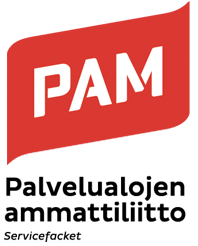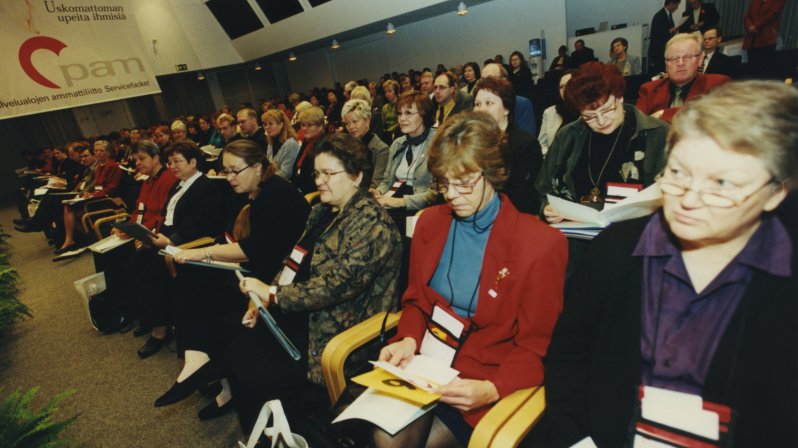PAM turns 20
Service Union United PAM was founded at the inaugural meeting in Finlandia Hall on 28 November 2000 and the combined union began operating from the start of 2001.
Following the inaugural meeting, the 160-member Delegate Council was PAM’s supreme decision-making body for a two-year transitional period, until a new Delegate Council was elected by members in 2002.
The election of the Delegate Council for the transitional period was unusual. Eighty of the members were elected by the Union of Commercial Employees in Finland at the last meeting of its own Delegate Council on 28 November 2000. An extraordinary meeting of delegates of the Hotel and Restaurant Workers’ Union HRHL, also on 28 November, elected 40 members to the Delegate Council. At the same time, an extraordinary meeting of the Caretakers’ Union and an extraordinary delegates’ meeting of the Technical and Special Trades Union each elected 20 members to the Delegate Council.
The first meeting of the Delegate Council of the new Service Union United PAM was held the day after the inaugural meeting, on 29 November. The meeting elected the then chairman of the Union of Commercial Employees, Maj-Len Remahl, as President of PAM; the then chairman of HRHL, Jorma Kallio, was elected 1st Vice President; and the supervisor for Eastern Finland of the Union of Commercial Employees, Kaarlo Julkunen, was elected 2nd Vice President. The candidates were proposed by the executive committees and union committees of the founding unions.
The first meeting of the Delegate Council approved the new union’s declaration of principles, the strategy and financial plan for 2001 and the membership fees for 2001. It was also decided to transfer the collective agreements to PAM. The PAM Unemployment Fund began operating from the start of 2001.

PAM’s mission was set out at the inaugural meeting
Service Union United began operating at the start of 2001 amid high expectations. A particular focus was on the union’s ability to influence society and its public image.
“It is important that the new union is seen and heard right from the start”, stressed Sirkka-Liisa Rosenlund from Helsinki at the delegates’ meeting of the Union of Commercial Employees.
PAM’s inaugural meeting also defined the new union’s central advocacy themes, which are still relevant today. In the first year, advocacy concentrated on themes that are familiar today, such as coping at work, safety at work and monitoring agency employment. Enhancing professional identity and better service to members were also seen as important areas to work on.
PAM in a nutshell
Service Union United PAM is a trade union for employees in private service sectors. PAM has around 210,000 members, 76% of whom are women. The majority of PAM members work in retail, hospitality services, facility services and private security. PAM negotiates collective agreements for service sectors and monitors members’ interests at the workplace.
Core mission
• Our core mission is to be a trade union for employees in private service sectors. As a specialist in working life, we improve our members’ livelihoods, job security and quality of life.
• Our main task is to negotiate collective agreements for service sectors. We improve the ability of employees in our sectors to influence their employment, safety at work and better business activity. We promote democracy, justice, equality and social security, both nationally and internationally.
Council
• Chairman and 2 deputy chairmen, 50 members and 10 general deputy members. Full members have 3 personal deputies. Term of office four years.
Executive Committee
• Union President, President’s personal deputy, 15 members and 3 general deputy members.
Branches
• 159
Collective agreements
• 34, of which 18 universally applicable, 4 ordinarily applicable, 12 company-specific (2018)



